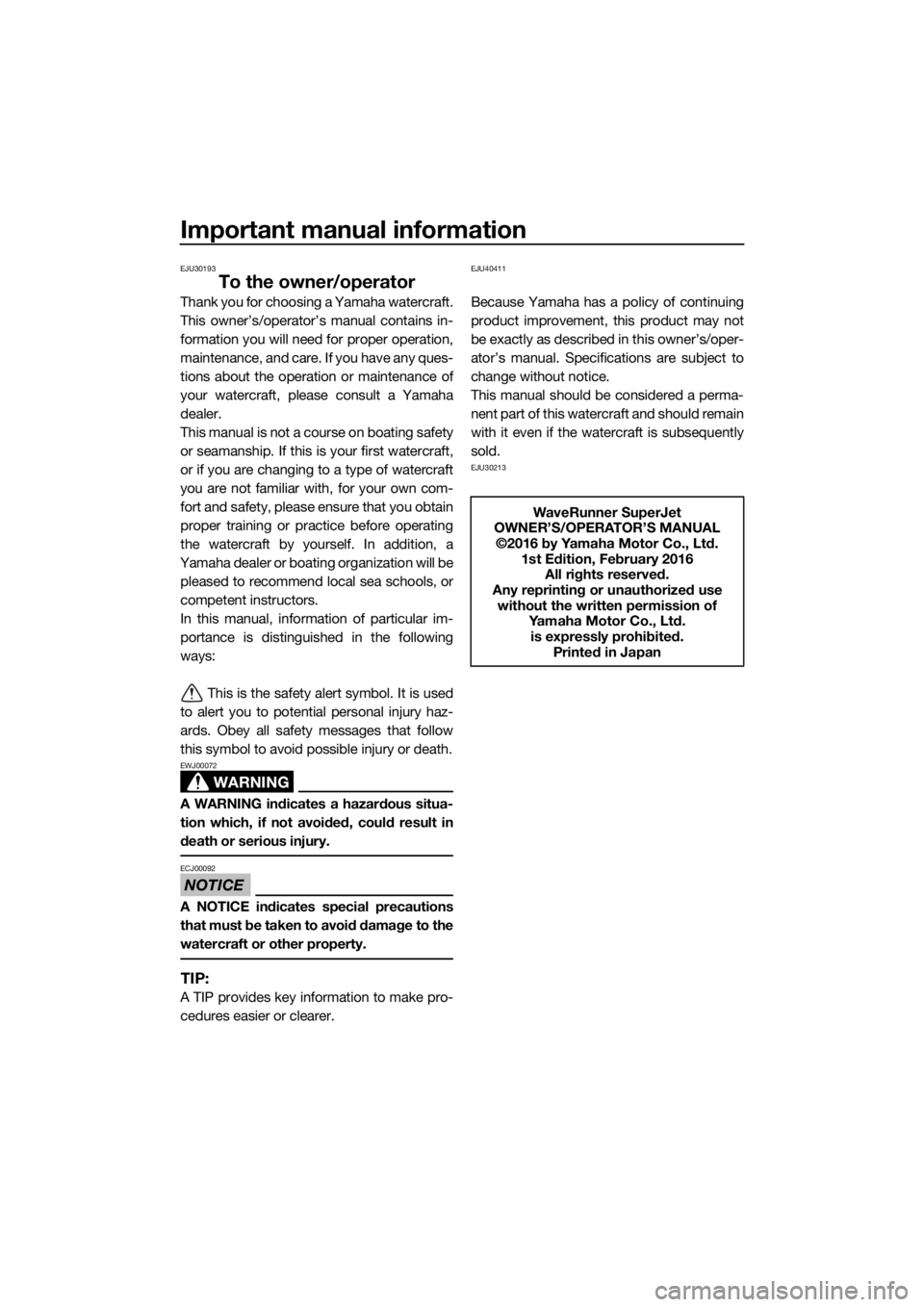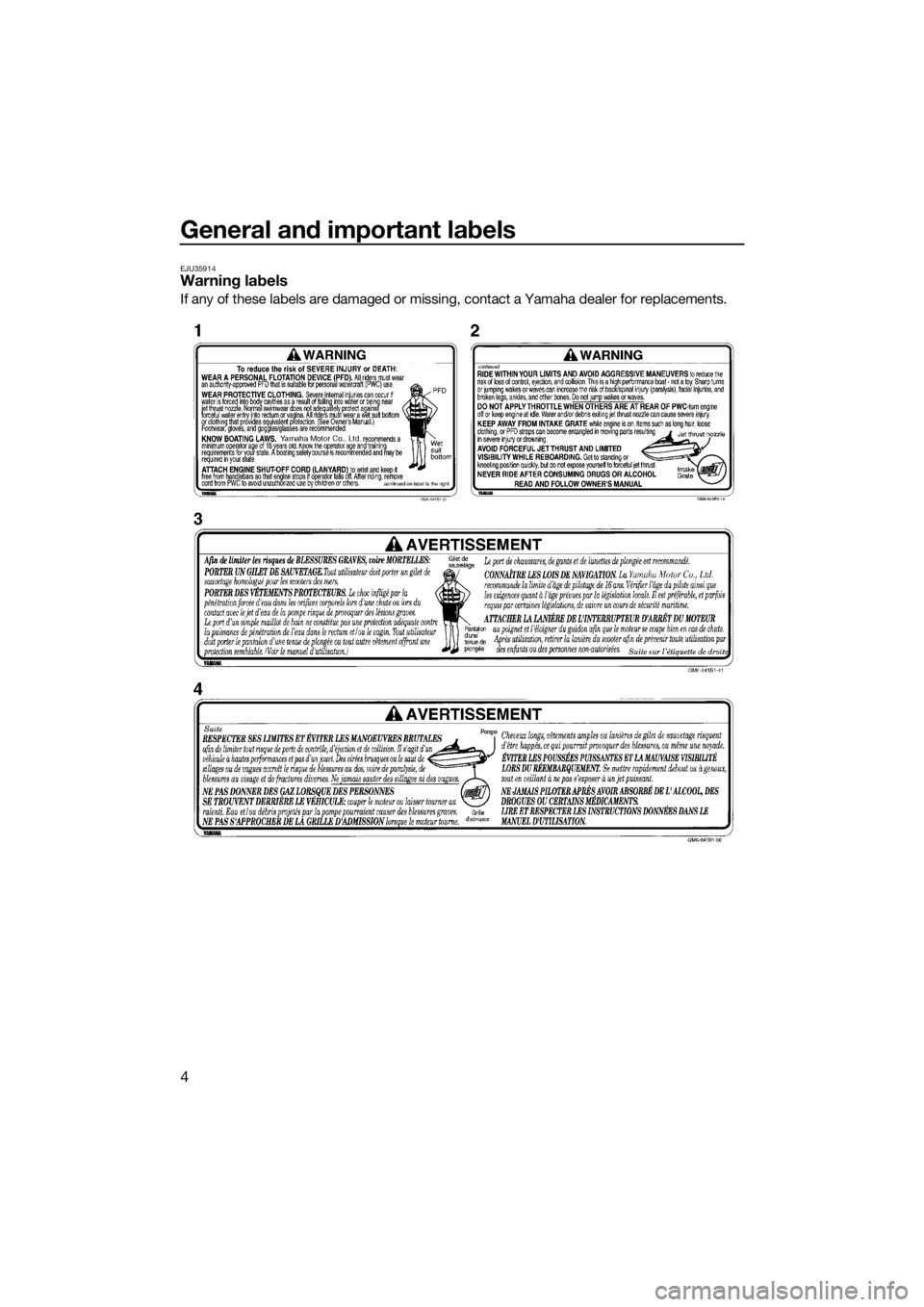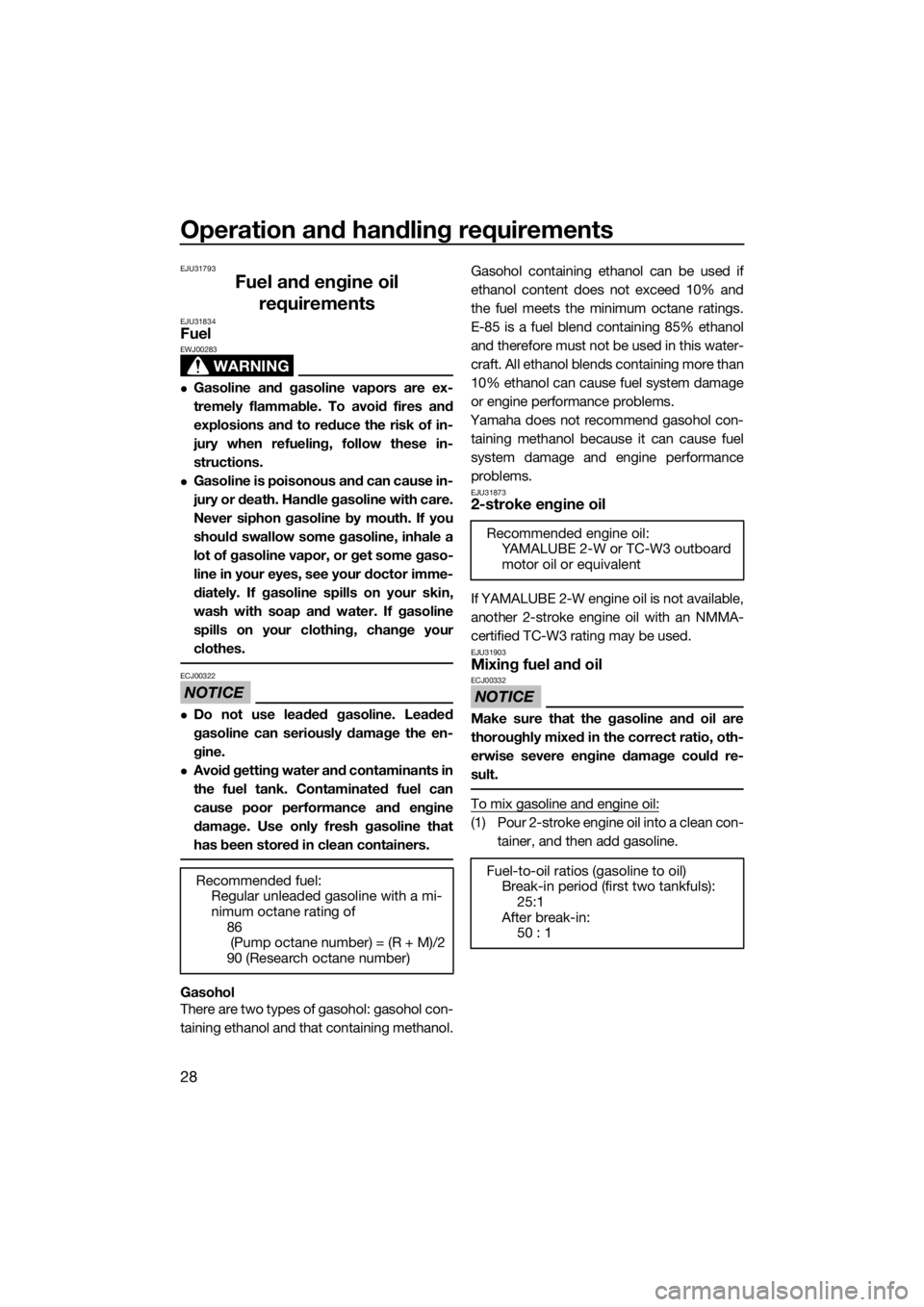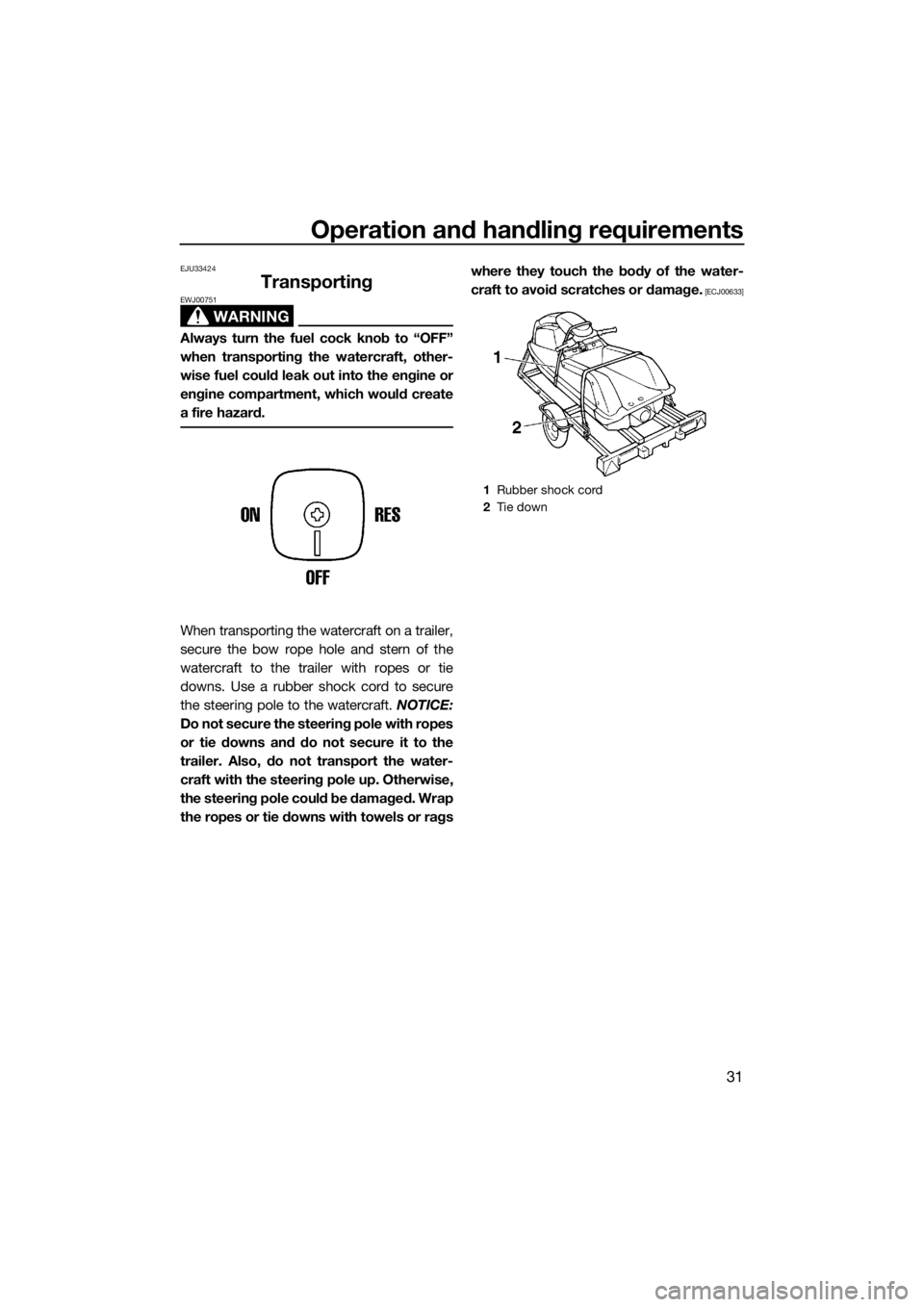2017 YAMAHA SUPERJET warning
[x] Cancel search: warningPage 4 of 78

Important manual information
EJU30193
To the owner/operator
Thank you for choosing a Yamaha watercraft.
This owner’s/operator’s manual contains in-
formation you will need for proper operation,
maintenance, and care. If you have any ques-
tions about the operation or maintenance of
your watercraft, please consult a Yamaha
dealer.
This manual is not a course on boating safety
or seamanship. If this is your first watercraft,
or if you are changing to a type of watercraft
you are not familiar with, for your own com-
fort and safety, please ensure that you obtain
proper training or practice before operating
the watercraft by yourself. In addition, a
Yamaha dealer or boating organization will be
pleased to recommend local sea schools, or
competent instructors.
In this manual, information of particular im-
portance is distinguished in the following
ways:
This is the safety alert symbol. It is used
to alert you to potential personal injury haz-
ards. Obey all safety messages that follow
this symbol to avoid possible injury or death.
WARNING
EWJ00072
A WARNING indicates a hazardous situa-
tion which, if not avoided, could result in
death or serious injury.
NOTICE
ECJ00092
A NOTICE indicates special precautions
that must be taken to avoid damage to the
watercraft or other property.
TIP:
A TIP provides key information to make pro-
cedures easier or clearer.
EJU40411
Because Yamaha has a policy of continuing
product improvement, this product may not
be exactly as described in this owner’s/oper-
ator’s manual. Specifications are subject to
change without notice.
This manual should be considered a perma-
nent part of this watercraft and should remain
with it even if the watercraft is subsequently
sold.
EJU30213
WaveRunner SuperJet
OWNER’S/OPERATOR’S MANUAL
©2016 by Yamaha Motor Co., Ltd.
1st Edition, February 2016
All rights reserved.
Any reprinting or unauthorized use
without the written permission of
Ya m a h a M o t o r C o . , L t d .
is expressly prohibited.
Printed in Japan
UF4D73E0.book Page 2 Wednesday, March 23, 2016 11:40 AM
Page 5 of 78

Table of contents
General and important labels ........... 1
Identification numbers .................... 1
Primary Identification (PRI-ID)
number............................................ 1
Craft Identification Number (CIN) ....... 1
Engine serial number.......................... 1
Manufactured date label .................... 2
Important labels .............................. 3
Warning labels.................................... 4
Other labels ........................................ 7
Safety information ............................. 8
Limitations on who may operate
the watercraft ............................... 8
Cruising limitations .......................... 9
Operation requirements ................ 10
Recommended equipment ........... 12
Hazard information........................ 13
Watercraft characteristics ............. 13
Safe boating rules ......................... 14
Enjoy your watercraft
responsibly ................................. 15
Description....................................... 16
Watercraft glossary ....................... 16
Location of main components ...... 17
Control function operation ............. 19
Watercraft control functions ......... 19
Engine stop switch .......................... 19
Engine shut-off switch .................... 19
Start switch ..................................... 19
Throttle lever .................................... 20
Steering system ............................... 20
Steering pole .................................... 20
Fuel cock knob................................. 21
Choke knob ..................................... 21
Cooling water pilot outlet ................. 21
Water separator................................ 22
Engine overheat warning system ..... 22
Equipment operation ...................... 24
Equipment..................................... 24
Hood................................................. 24
Bow rope hole .................................. 25
Stern rope hole ................................. 25
Storage pouch .................................. 25
Fire extinguisher container ............... 26
Operation and handling
requirements ................................... 28
Fuel and engine oil
requirements .............................. 28
Fuel................................................... 28
2-stroke engine oil ............................ 28
Mixing fuel and oil ............................ 28
Filling the fuel tank ........................... 29
Draining the bilge water ................ 30
Draining the bilge water on water .... 30
Transporting.................................. 31
First-time operation ........................ 32
Engine break-in............................. 32
Pre-operation checks ..................... 33
Pre-operation checklist .................... 33
Pre-operation check points .......... 35
Pre-launch checks ........................... 35
Post-launch checks.......................... 39
Operation ......................................... 40
Operating your watercraft ............. 40
Getting to know your watercraft....... 40
Learning to operate your
watercraft ...................................... 40
Operating positions .......................... 40
Launching the watercraft ................. 41
Starting the engine on water ............ 41
Stopping the engine ......................... 43
Leaving the watercraft ...................... 43
Operating the watercraft .................. 43
Turning the watercraft ...................... 43
Stopping the watercraft.................... 45
Starting off........................................ 45
UF4D73E0.book Page 1 Wednesday, March 23, 2016 11:40 AM
Page 10 of 78

General and important labels
4
EJU35914Warning labels
If any of these labels are damaged or missing, contact a Yamaha dealer for replacements.
UF4D73E0.book Page 4 Wednesday, March 23, 2016 11:40 AM
Page 28 of 78

Control function operation
22
proper operation of the cooling system, make
sure that water is being discharged from the
cooling water pilot outlet. If water is not being
discharged from the outlet, stop the engine
and check the jet intake for clogging. (See
page 66 for information on the jet intake.)
TIP:
It will take about 20 seconds for the water
to reach the outlet after the engine is start-
ed.
Water discharge may not be constant
when the engine is running at idling speed.
If this occurs, apply a little throttle to make
sure that water discharges properly.
EJU40323Water separator
The water separator prevents water from en-
tering the fuel tank by collecting any water
that has entered the fuel tank breather hose if
the watercraft was capsized.If water has collected in the water separator,
drain it by loosening the drain screw.
To drain water from the water separator:
(1) Place a drain pan or dry cloth under the
water separator.
(2) Gradually loosen the drain screw to drain
the water. Catch the draining water in the
drain pan or soak it up with the dry cloth
so that it does not spill into the engine
compartment. If any water spills into the
watercraft, be sure to wipe it up with a
dry cloth.
(3) Securely tighten the drain screw until it
stops.
EJU31665Engine overheat warning system
If the engine temperature rises significantly,
the engine overheat warning system will acti-
vate and the engine speed will be limited to
about 3400 r/min to help prevent damage.
1Water separator
1Drain screw
1
UF4D73E0.book Page 22 Wednesday, March 23, 2016 11:40 AM
Page 29 of 78

Control function operation
23
If the engine overheat warning system is acti-
vated, immediately reduce the engine speed,
return to shore, and then make sure that wa-
ter is being discharged from the cooling wa-
ter pilot outlet while the engine is running. If
there is no discharge of water, stop the en-
gine, and then check the jet intake for clog-
ging. (See page 66 for information on the jet
intake.) NOTICE: If you cannot locate and
correct the cause of the overheating, con-
sult a Yamaha dealer. Continuing to oper-
ate at higher speeds could result in severe
engine damage.
[ECJ00042]
UF4D73E0.book Page 23 Wednesday, March 23, 2016 11:40 AM
Page 34 of 78

Operation and handling requirements
28
EJU31793
Fuel and engine oil
requirements
EJU31834Fuel
WARNING
EWJ00283
Gasoline and gasoline vapors are ex-
tremely flammable. To avoid fires and
explosions and to reduce the risk of in-
jury when refueling, follow these in-
structions.
Gasoline is poisonous and can cause in-
jury or death. Handle gasoline with care.
Never siphon gasoline by mouth. If you
should swallow some gasoline, inhale a
lot of gasoline vapor, or get some gaso-
line in your eyes, see your doctor imme-
diately. If gasoline spills on your skin,
wash with soap and water. If gasoline
spills on your clothing, change your
clothes.
NOTICE
ECJ00322
Do not use leaded gasoline. Leaded
gasoline can seriously damage the en-
gine.
Avoid getting water and contaminants in
the fuel tank. Contaminated fuel can
cause poor performance and engine
damage. Use only fresh gasoline that
has been stored in clean containers.
Gasohol
There are two types of gasohol: gasohol con-
taining ethanol and that containing methanol.Gasohol containing ethanol can be used if
ethanol content does not exceed 10% and
the fuel meets the minimum octane ratings.
E-85 is a fuel blend containing 85% ethanol
and therefore must not be used in this water-
craft. All ethanol blends containing more than
10% ethanol can cause fuel system damage
or engine performance problems.
Yamaha does not recommend gasohol con-
taining methanol because it can cause fuel
system damage and engine performance
problems.
EJU318732-stroke engine oil
If YAMALUBE 2-W engine oil is not available,
another 2-stroke engine oil with an NMMA-
certified TC-W3 rating may be used.
EJU31903Mixing fuel and oil
NOTICE
ECJ00332
Make sure that the gasoline and oil are
thoroughly mixed in the correct ratio, oth-
erwise severe engine damage could re-
sult.
To mix gasoline and engine oil:
(1) Pour 2-stroke engine oil into a clean con-
tainer, and then add gasoline.
Recommended fuel:
Regular unleaded gasoline with a mi-
nimum octane rating of
86
(Pump octane number) = (R + M)/2
90 (Research octane number)
Recommended engine oil:
YAMALUBE 2-W or TC-W3 outboard
motor oil or equivalent
Fuel-to-oil ratios (gasoline to oil)
Break-in period (first two tankfuls):
25:1
After break-in:
50 : 1
UF4D73E0.book Page 28 Wednesday, March 23, 2016 11:40 AM
Page 37 of 78

Operation and handling requirements
31
EJU33424
Transporting
WARNING
EWJ00751
Always turn the fuel cock knob to “OFF”
when transporting the watercraft, other-
wise fuel could leak out into the engine or
engine compartment, which would create
a fire hazard.
When transporting the watercraft on a trailer,
secure the bow rope hole and stern of the
watercraft to the trailer with ropes or tie
downs. Use a rubber shock cord to secure
the steering pole to the watercraft. NOTICE:
Do not secure the steering pole with ropes
or tie downs and do not secure it to the
trailer. Also, do not transport the water-
craft with the steering pole up. Otherwise,
the steering pole could be damaged. Wrap
the ropes or tie downs with towels or ragswhere they touch the body of the water-
craft to avoid scratches or damage.
[ECJ00633]
1Rubber shock cord
2Tie down
UF4D73E0.book Page 31 Wednesday, March 23, 2016 11:40 AM
Page 39 of 78

Pre-operation checks
33
EJU31982
WARNING
EWJ00412
Failure to inspect or maintain the watercraft properly increases the possibility of an ac-
cident or damage to the watercraft. Do not operate the watercraft if you find any prob-
lem. If a problem cannot be corrected by the procedures provided in this manual, have
the watercraft inspected by a Yamaha dealer.
EJU41234Pre-operation checklist
Before using this watercraft, be sure to perform the checks in the following checklist.
ITEM ROUTINE PAGE
PRE-LAUNCH CHECKS
Engine compartmentVentilate the engine compartment.
Check inside the engine compartment for damage.35
Fuel systemCheck the fuel system for leakage.
Check the fuel level in the fuel tank.35
Water separatorCheck the water separator for water. 36
Engine unitCheck the exterior of the engine unit for damage. 36
Bilge waterCheck the engine compartment for bilge water. 36
BatteryCheck the battery connections and electrolyte level. 36
Steering systemCheck the steering system for proper operation. 36
Throttle leverCheck the throttle lever for proper operation.
Check the throttle lever free play.37
Engine shut-off cord (lan-
yard)Check the engine shut-off cord (lanyard) for dam-
age.38
SwitchesCheck the start switch, engine stop switch, and en-
gine shut-off switch for proper operation.38
Storage pouchCheck the storage pouch for damage and water.
Check that the storage pouch is securely installed.38
Fire extinguisher containerCheck the fire extinguisher container for damage. 39
Fire extinguisherCheck the condition of the fire extinguisher. 39
Safety equipmentCheck that safety equipment meeting the applica-
ble regulations is on board.39
Hull and deckCheck the hull and deck for damage. 39
Jet intakeCheck the jet intake for damage and clogging. 39
HoodCheck that the hood is securely closed. 39
UF4D73E0.book Page 33 Wednesday, March 23, 2016 11:40 AM